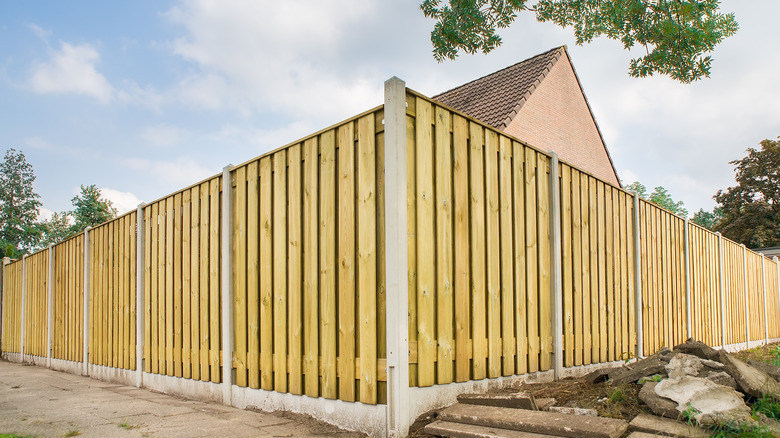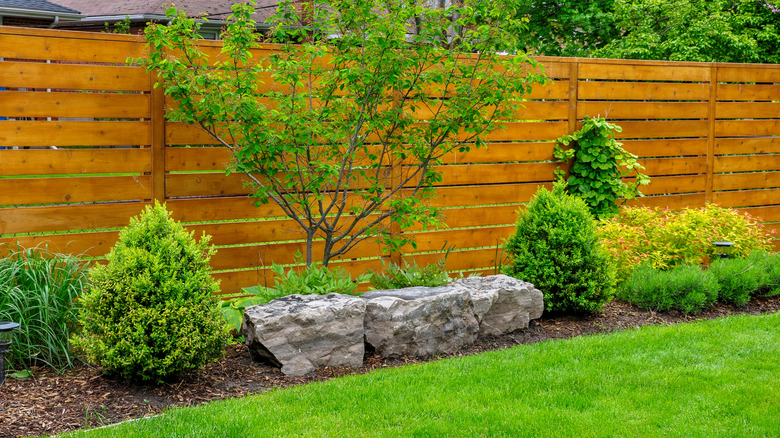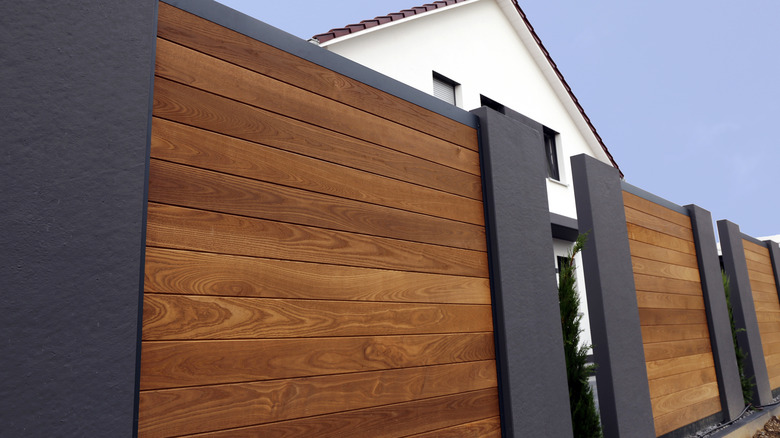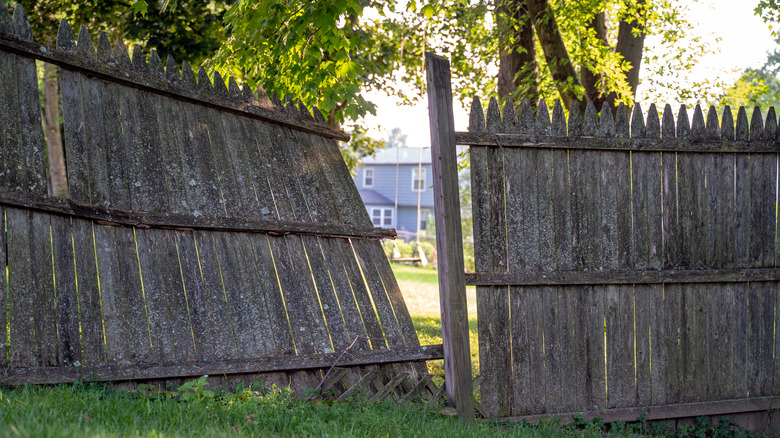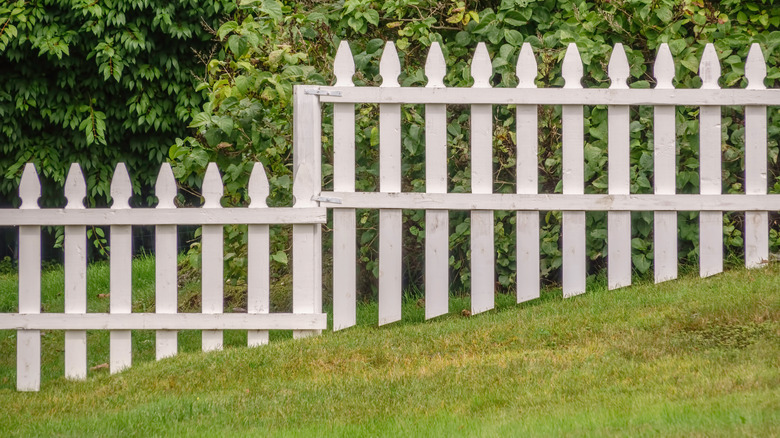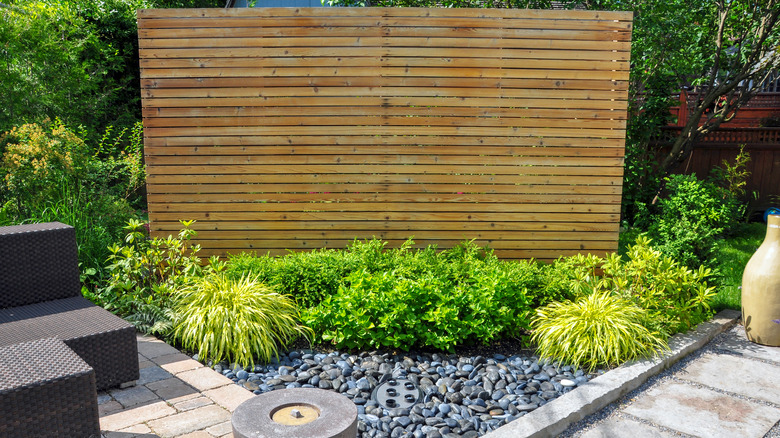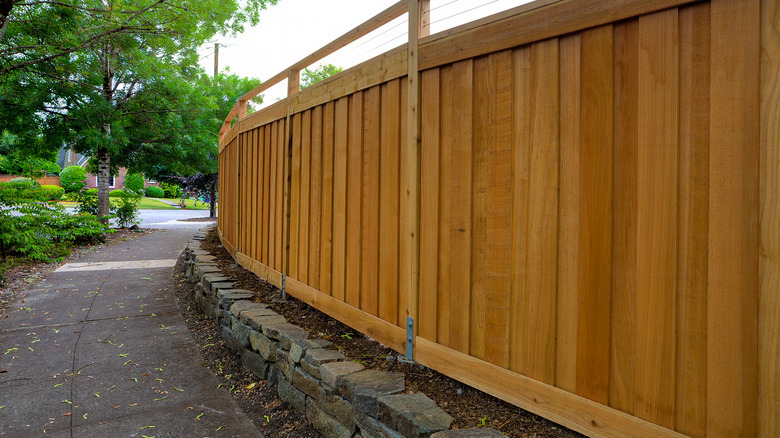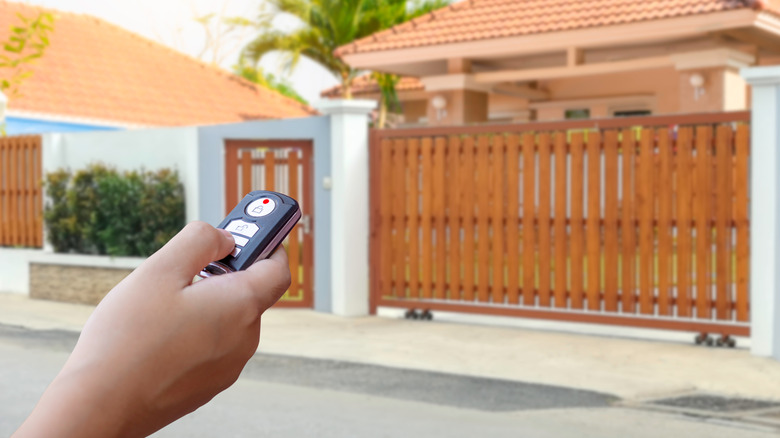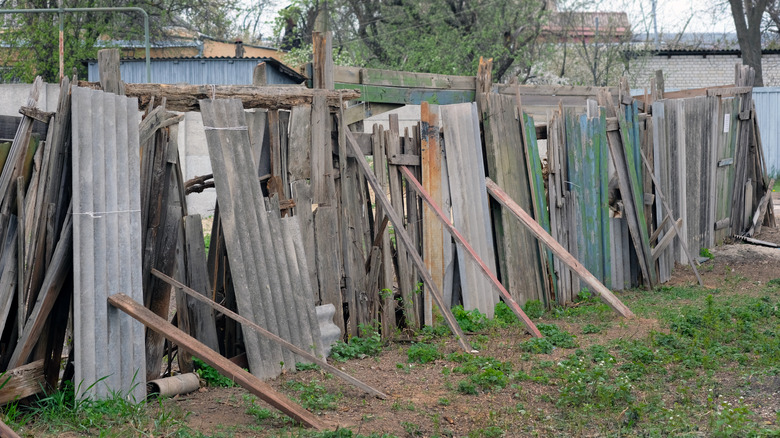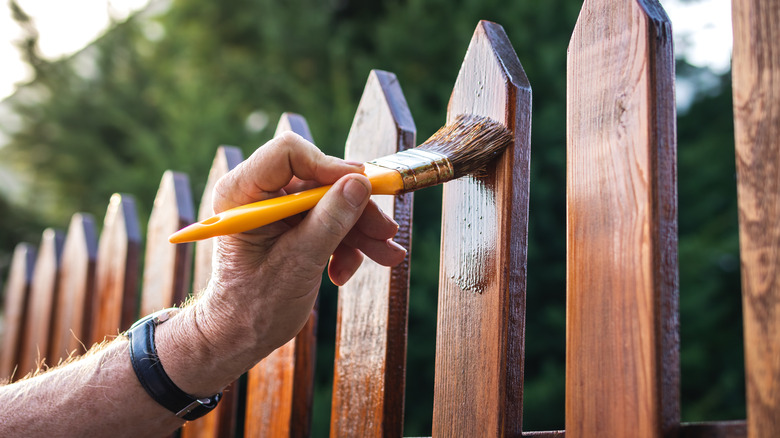Horizontal Vs. Vertical Fences: Which Is Best For Your Home?
A fence doesn't just keep things out, if it even manages to do that much. Fences are decorative, and they are a means of communicating with others either about our aesthetic sensibilities, our expectations of others, and our relationship with a piece of land. British ironmonger and metal fabricator John Desmond writes that fences aren't only about limits, but also creating a relationship between spaces. They define how we and others behave, and how occupants of either space feel about the space. They are means of saying "keep out" or "don't pry," but can also say "you are welcome, but rabbits are not," or "I don't mind if you look, but the cows should stay over here." And, no doubt, they also say things like "my priorities include making this space more beautiful," and sometimes adding that we can't be dissuaded by additional costs.
The typical homeowner probably has a fairly narrow range of images come to mind in reaction to the word "fence." In urban and suburban America, it might look something like a generic wood stockade-style privacy fence. But there are a lot more choices than wood, a lot more styles than stockade, and most important: at least one fashionable alternative to vertical fencing.
Horizontal fencing (in which the boards run parallel to the ground, as opposed to upright pickets) doesn't do many things better than vertical fencing. It's more expensive and less flexible, and while it might be more durable than vertical fencing, it is prone to deteriorating in a way that quickly undermines its reason for being. A rotting vertical fence will keep coyotes out and collies in about as well as a new one, but a sagging horizontal fence immediately communicates something other than "I am stylish and affluent."
Vertical fence structure
Setting aside matters of style for a moment, vertical fences, at least as they exist in the imaginations and on the lawns of suburban homeowners, have big advantages and equally big drawbacks when it comes to their construction. Vertical fencing can be flexible and, therefore, both easier and cheaper to install, but it is also encumbered with a tendency to deteriorate quickly.
It helps to understand the structure of a vertical fence. Usually, it's some version of this: posts, perhaps 4x4s, are set along the fence path six to eight feet apart, according to Outdoor Essentials. Between these, horizontal backer rails (also known as stringers) are screwed or nailed just above the bottom and just below the top of the fence, and sometimes also in the middle. To these rails, the pickets that we think of as the fence itself are affixed (with nails, screws, or specialized clips). Materials and ornamentation vary wildly in real-world fences. Picket tops come in different styles, as do post caps. The fence might include kick boards, cap boards, gates, and all manner of trim. And sometimes there are two layers of picket, offset to help with privacy while allowing airflow. But the basic structure of a vertical fence is usually something like this.
There are a few important things to note about this method of adding a fence like this to your property. One is that the wood's end grain, which is the part of a board most vulnerable to water intrusion, is exposed in the worst ways to moisture from the sky and the ground. Another is that there's no requirement that the pickets be attached at the same height, making it possible to adjust to undulating land every few inches.
Horizontal fence structure
Horizontal fences, on the other hand, present the carpenter (and therefore the homeowner as well) with a few minor construction advantages (which are often erased in the final product), and with some important downsides. The most important construction advantage is probably that, using certain construction methods, a horizontal fence can be built with less wood... but horizontal fences still tend to cost more than vertical ones, making this an environmental win more than a financial one. The key drawbacks are that horizontal fences can be relatively inflexible to install, and so aren't suitable for all properties. And if they're not installed perfectly, they have a habit of sagging noticeably... which undermines the clean, modern geometric orderliness of the style.
Horizontal fences start with posts just like vertical fences, according to Dunn Lumber's DIY primer on building horizontal fences. The posts are spaced, at a minimum at the length of the horizontal boards to be installed. So a fence with eight-foot boards would require posts spaced no more than eight feet apart. The most basic version of the horizontal fence doesn't include horizontal rails, but they can be used and there's good reason to do so. The only problem is that rails for horizontal fences should be run between the posts, not attached to the post faces as you would with a vertical fence. There are a number of ways of accomplishing this, such as notching the posts so the rails can be inset, which preserves the flat plane on which to install the horizontal fence boards.
Rails add stability to the fence, as do more closely spaced posts. Vertical supports can be used in place of additional posts. This works best for horizontal fences with rails, to which the additional vertical supports can be attached.
Pretty fences make pretty neighborhoods
It's hard to find anyone who will argue that vertical fencing is preferable to horizontal when it comes to stylistic trendiness. That could change next year, and will almost certainly change eventually, but for now the look is simply considered more modern. This has important concrete advantages in terms of home value, disguising or emphasizing characteristics of the house, etc.
Of course, there are circumstances in which vertical fencing is the more stylish of two choices as well. A privacy fence will usually be considered better-looking than a chain-link fence. And suburbanites might feel that a stockade-style fence is better looking than typical agricultural field fencing, though rural homeowners might roll their eyes at this. In general, and especially when it comes to protecting home value, a solid fence (horizontal or vertical) will usually be preferred to a wire fence. And the more solid the better, says Straight Line Fences, especially when privacy or security are at issue.
The more contemporary look of the horizontal fence evokes the clean lines and minimalism that evolved over the 20th century and especially from mid-century modern style. And it's a natural fit for fencing, since the dominant orientation of a fence is usually horizontal to begin with. When a fence doesn't have a vertical or horizontal orientation, as with laser-cut fence panels, the overall effect is of a horizontal design, with panels laid on their long edges (via Outdoor Essentials).
Also, horizontal fences emphasize or enhance the size of your property, and can easily be designed to accentuate the architectural style of your home (via Homedit). But note that a horizontal fence can make your house look shorter, which might or might not be a desirable trait.
Cost confusion
As a rule, horizontal fences are slightly more costly to buy and install than vertical fencing... generally around 10-20 percent more than vertical fences constructed of similar materials and methods. It might look like a minor difference at first glance, but the final bill can be dramatically different. Using Hoover Fence Company's calculations for fencing a one-square-acre parcel, a $22/linear foot horizontal fence would cost $1670 more to install than a $20/linear foot vertical fence.
Fixr's cost ranges for wood fencing are solid, and certainly reliable enough for back-of-envelope estimations. But there are a lot of variables in fencing decisions that affect your final cost, so it's difficult to generalize accurately. Fence style matters, obviously, as does the type of wood used, height, the amount of material needed, the number of posts needed (vertical fences can sometimes require fewer), etc. But in general, a stockade-style vertical fence averages $5-10 per linear foot for materials, and $15-20 installed. By contrast, a horizontal wood fence costs $5-12 for materials and $15-22 per linear foot installed. One peculiar thing about these numbers is that they imply that the labor cost is the same between fence styles, but it's generally acknowledged that horizontal fencing is more exacting and therefore requires more labor.
Note that we're comparing horizontal fencing to stockade-style fences because the privacy fencing discussed by Fixr ($7-17 per linear foot for materials, $17-37 installed) tends to be taller than the six feet average for most fences. Since the height isn't constant, a direct comparison is impossible. Also, this particular style of privacy fencing is solid (there are no gaps between pickets), which makes both the materials and installation prices higher.
Strength and durability
The most basic vertical fence tends to be sturdier than an equivalent horizontal fence because of the 2x4 (or similar) stringers run horizontally for attaching pickets. This is somewhat mitigated by the more closely spaced posts used for horizontal fencing. And certain horizontal fencing methods are very strong, though they come with higher price tags.
As we mentioned at the outset, wood vertical fencing does tend to expose the wood's end grain to moisture ingress, resulting in rotting and obviously weakened boards. This can be partly managed by regular inspection and sealing, but this only lessens and does not eliminate the problem. And wood making ground contact will fare worse than wood that isn't, so the posts in both horizontal and vertical styles are at risk, according to This Old House.
Other factors affect a fence's durability. Materials matter (redwood, cedar, and pressure-treated pine tend to make the most long-lived fences), and the size of the gaps between boards has an effect as well, since smaller gaps mean that wind damage is more likely (via Jackson's Fencing). Given all the variables, it's hard to say which fencing style tends to be the strongest. But as a rule, vertical fences are strengthened a little by the even distribution of their weight, while horizontal fences tend to sag if not properly reinforced with posts or cross-beams, a problem vertical fences don't have.
The levelness of your lot
One key factor in deciding between vertical and horizontal fencing is the levelness of the lot being fenced. As we hinted in the section on vertical fence construction, as a rule of thumb, horizontal fences are more suitable for level, flat lots. There are various methods of fencing sloped ground, some of which will make it possible to install horizontal fences on uneven land, and all of which tend to get better results with vertical fencing.
The basic methods of dealing with property that won't lie flat, according to Bravo Fence Company, are constructing a level-topped fence, using stepped fencing, using a racked fence, or installing a hinged racked fence. The level-topped fence is for lots that are flat overall (that is, are level on both ends of a run of fence) but are graced with the occasional rise or fall along the way. Stepped fencing is also very common. In this method, each post-to-post section of fencing is adjusted for the level of its own ground, creating 6-8-foot sections that step up and down as you move along the fence line. Racking a fence is a method by which each picket is installed at a unique height, so the top of the fence rises and falls with the land.
Of course, there are always bespoke solutions customized for your lot... a process which can involve inspections, design, fiddly permitting procedures, and endless revision, none of which is free.
Lot levelness... horizontal edition
The horizontal fence's natural predisposition toward a level lot is right there in its name: horizontal, like the horizon, without a lot of wishy-washy vertical up-and-downness. The same methods used for vertical fencing can be used for horizontal fencing, says Trex Fence, but with different levels of effort and success.
A sloped install, fairly standard for vertical fencing, becomes a nightmarish production for horizontal fences. Every board is of a slightly different length and each run involves a new angle of cuts, all of which requires more labor and produces far more waste. Stepped installations, in which the horizontal boards remain level but are stepped up and down at each post to fit the property contours, are fairly common. But a stepped horizontal loses some (or most) of its clean, modern characteristics (as some might argue that the non-horizontal runs of a sloped horizontal fence do, as well).
The upshot is that horizontal fencing fares better on very level lots, or in very short lengths of fencing that can be installed on flat land (or land that can be graded flat).
Not all woods are created equal
If you've never seen a wooden fence in need of repairs, you haven't looked at many wooden fences. Wood exposed to the elements will warp, twist, and otherwise dance about like River Tam about to be kidnapped. Fences, of course, don't have to be wood, even if that's the look you're going for. But if they are wood, it's important to recognize that not all woods are created equal.
Cedar, redwood, and fir are naturals at avoiding warping, according to Discount Fence USA. Ipe is another option that is dense, fire- and insect-resistant, and virtually rot-proof, but it's also very expensive, about the price of clear cedar (via Brownstoner). The best compromise might be knotty cedar, which has all the benefits at one-fourth the cost of clear cedar (via Florida State Fence). You might also consider pressure-treated boards, which are somewhat moisture-proof.
Of course, where wood is involved, there are factors other than species that can help with warping, twisting, and shrinkage. Flaw-sawn boards don't tend to crook, while quarter-sawn boards tend to shrink evenly and thereby resist warping. It's also important to dry/cure and store wood properly, and to seal the boards after they're installed (via Discount Fence USA).
If you're just not that into wood, vinyl and composite wood are both extremely durable, have long warranties, and are immune to problems like insects and warping, though they are comparatively expensive. But on the whole, material choice is more key for horizontal fences, the appearance of which is destroyed by even a little sagging.
Safety, privacy, security, and paranoia
If your fencing project is driven by safety concerns (enclosing a pool, for example, or keeping kids out of a busy street), there are some considerations that might make you prefer horizontal versus vertical fencing, and vice versa. Unsurprisingly, the privacy fence is still the best for privacy and does pretty well when it comes to safety and security as well. They add that iron and aluminum fences better resist "ramming," but depending on your neighborhood fence-ramming might not be that much of an issue.
Climbing fences is a more realistic problem, both from a security and a safety point of view, because they are relatively difficult to scale for children, dogs, and criminals who didn't think to bring the rammin' car. Vertical fences, with no footholds, are more difficult to climb. Horizontal fences can be a bit easier to climb, especially when slats are spaced far apart.
With horizontal fencing, you can adjust the spacing for better privacy, including varying the gap between boards from top to bottom... e.g., having wider spacing near the top (via Brownstoner). But overall, vertical fences tend to be slightly more secure and private, and perhaps a little safer.
Home value and other values
In certain circumstances, the existence of a fence can improve a home's value, but it's not a given. And in most of those situations, a horizontal fence will produce better return on investment than a vertical fence, though there are exceptions. Here are a few tips to maximize your fencing investment.
D2 Landscaping encourages you to match your fence to your house. If your house is modern, horizontal lines, a horizontal fence will probably complement it better than a vertical fence. And you don't want the fence to just fit your house; it should also fit the neighborhood overall. Potential home buyers might be hesitant to consider a home that has a fence when no others in the neighborhood do, or a fence that is of a style radically out of step with the area. In terms of home value, a mismatched fence might be worth less than having no fence at all (via Straight Line Fences).
And remember that a home's resale value isn't everything. You'll get value from the utility and enjoyment of a fence while you live there, which might more than pay for any dings you take in the resale market.
Pros, cons and recommendations
From most angles, it's hard to avoid concluding that vertical fencing is the better, or at least more flexible, alternative. Vertical fences are cheaper, easier to customize, marginally safer, and arguably a little more private. They will accommodate more variation in your property than horizontal fences will. Your circumstances and priorities will determine how much these advantages really matter.
Even if vertical fencing has some advantages, it almost doesn't matter. Being a consumer of anything other than purely pragmatic goods means making irrational-seeming decisions... for example, about cars, clothes, houses, jewelry, even food. And in this regard, horizontal fencing has one huge, and maybe insurmountable advantage: they are, for now at least, considered more trendy and aesthetically more desirable, according to Bravo Fence Company. And whatever flexibility in construction you gain from vertical fencing can be offset with the pure style available to you with horizontal options (via BackyardScape). Even if you're trying to fence the neighbors out, there's a good chance you're also trying to impress them just a little.

